Sensitivity and Reliability Analysis of Ultrasonic Pulse Parameters in Evaluating the Laboratory Properties of Asphalt Mixtures
Abstract
:1. Introduction
- To establish the distribution function of the UPP for different asphalt mixtures and evaluate the reliability and sensitivity of three ultrasonic parameters in analyzing the performance of asphalt mixtures.
- To study the variation of three ultrasonic parameters in asphalt mixtures at dry and saturated states at different temperatures so as to provide a basis for formulating a standardized method for the UTT of asphalt mixtures.
- To analyze the correlation between three ultrasonic parameters and the asphalt aggregate ratio, aggregate content, volume indexes, and mechanical performance indexes at different temperatures; to study the internal mechanism affecting the ultrasonic travel speed in asphalt mixtures; and then to establish the functional relationship between the UPV and compressive strength of asphalt mixtures with temperature.
- To deduce the dynamic modulus of four asphalt mixtures at high-frequency load by using UPV and comparing them with the fitting results of the Sigmoid model, and then to analyze the feasibility of using ultrasonic to calculate the high-frequency dynamic modulus of asphalt mixtures.
2. Materials and Methods
2.1. Materials and Sample Preparation
2.2. Testing and Analytical Methods
2.2.1. Strategy of the Research
2.2.2. Ultrasonic Tests of Asphalt Mixtures
2.2.3. Splitting and Compression Failure Tests of Asphalt Mixtures
2.2.4. Dynamic Modulus Tests of Asphalt Mixtures
2.2.5. Grey Correlation Analysis of Asphalt Mixtures Properties
3. Research Results and Discussion
3.1. Traveling Characteristics of Ultrasonic Pulse in Mixtures
3.1.1. Distribution of UPP and Influence of Gradation
3.1.2. Effect of Temperature on UPP in Four Grades of Mixtures
3.1.3. Effect of Water on UPP in Four Grades of Mixtures
3.1.4. Effect of Freeze–Thaw Cycles on UPP in Four Grades of Mixtures
3.2. Correlation between UPP and Both Volume Indexes and Performance Indexes
3.2.1. Correlation between UPP and Volume Parameters
3.2.2. Correlation between UPP and Properties Parameters of Asphalt Mixture
3.2.3. Functional Relationship between UPV and Compression Properties
3.3. Application of UPV to Predict High-Frequency Dynamic Modulus of Asphalt Mixtures
4. Conclusions
- Ultrasonic traveling parameters in asphalt mixtures present a good normal distribution, in which the UPV is the most sensitive to the gradation change of asphalt mixtures and has obvious advantages in evaluating the performance of asphalt mixtures. The sensitivity of frequency is poor.
- With the increase in temperature, both the UPV and amplitude in dry and wet mixtures samples demonstrate a downward trend. Among them, OGFC mixtures with skeleton-gap structures have the largest decline. The maximum decreases in UPV and amplitude are 33.87% and 36.23%, respectively. The disordered movement of the mixture of medium particles intensifies after the temperature rises, which counteracts the orderly directional movement of the ultrasonic waves, resulting in the reduction of the transmitted sound energy. In addition, compared with other graded mixtures, freeze–thaw cycles also have the greatest impact on OGFC. After 14 freeze–thaw cycles, the UPV and amplitude decreased by 18.12% and 30.75%, respectively.
- Mixture density, asphalt content, and the content of 9.5~13.2 mm and 13.2~16 mm mineral aggregate have a greater impact on ultrasonic parameters. Increasing the content of coarse aggregates can facilitate the transmission of ultrasonic waves in asphalt mixtures.
- The ultrasonic parameters have a good correlation with the mechanical properties of the mixture. According to the quadratic function, the UPV can be applied to predict the compression strength at different temperatures, but the corresponding prediction functions of different mixtures are different. The existing equation can be employed to calculate the high-frequency dynamic modulus by UPV. The dynamic modulus of the OGFC and SMA mixture deduced by using the UPV at a high-frequency load has higher reliability.
Author Contributions
Funding
Institutional Review Board Statement
Informed Consent Statement
Data Availability Statement
Acknowledgments
Conflicts of Interest
Abbreviations
| UTT | Ultrasonic testing technology |
| UPP | Ultrasonic pulse parameters |
| UPV | Ultrasonic pulse velocity |
| 2S2P1D | Two springs, two parabolic elements, and one dashpot |
| SGC | Superpave gyratory compactor |
| AC | Suspended dense asphalt mixture |
| SUP | Superpave graded asphalt mixture |
| SMA | Skeleton dense asphalt mixture |
| OGFC | Skeleton void asphalt mixture |
| VV | Void ratio |
| VMA | Mineral aggregate |
| VFA | Voids filled with asphalt |
| γb | Bulk density |
| γa | Apparent density |
| γs | Apparent dry density |
| γv | Geometric density |
References
- Najim, K.B.; Hall, M.R. Mechanical and dynamic properties of self-compacting crumb rubber modified concrete. Constr. Build. Mater. 2012, 27, 521–530. [Google Scholar] [CrossRef]
- Zhang, W.; Akber, M.A.; Hou, S.; Bian, J.; Zhang, D.; Le, Q. Detection of Dynamic Modulus and Crack Properties of Asphalt Pavement Using a Non-Destructive Ultrasonic Wave Method. Appl. Sci. 2019, 9, 2946. [Google Scholar] [CrossRef]
- Arabani, M.; Kheiry, P.T.; Ferdowsi, B. Use of Ultrasonic Pulse Velocity (Upv) for Assessment of Hma Mixtures Behavior. Iran. J. Sci. Technol. Trans. Civ. Eng. 2012, 36, 111–114. [Google Scholar]
- Majhi, D.; Karmakar, S.; Roy, T.K. Reliability of Ultrasonic Pulse Velocity Method for Determining Dynamic Modulus of Asphalt Mixtures. Mater. Today Proc. 2017, 4, 9709–9712. [Google Scholar] [CrossRef]
- In, C.-W.; Kim, J.-Y.; Kurtis, K.E.; Jacobs, L.J. Characterization of ultrasonic Rayleigh surface waves in asphaltic concrete. NDT E Int. 2009, 42, 610–617. [Google Scholar] [CrossRef]
- McGovern, M.E.; Behnia, B.; Buttlar, W.G.; Reis, H. Concrete Testing: Characterisation of oxidative ageing in asphalt concrete—Part 2: Estimation of complex moduli. Insight Non-Destr. Test. Cond. Monit. 2013, 55, 605–609. [Google Scholar] [CrossRef]
- Di Benedetto, H.; Sauzéat, C.; Sohm, J. Stiffness of Bituminous Mixtures Using Ultrasonic Wave Propagation. Road Mater. Pavement 2011, 10, 789–814. [Google Scholar] [CrossRef]
- Mounier, D.; Di Benedetto, H.; Sauzéat, C. Determination of bituminous mixtures linear properties using ultrasonic wave propagation. Constr. Build. Mater. 2012, 36, 638–647. [Google Scholar] [CrossRef]
- Larcher, N.; Takarli, M.; Angellier, N.; Petit, C.; Sebbah, H. Towards a viscoelastic mechanical characterization of asphalt materials by ultrasonic measurements. Mater. Struct. 2014, 48, 1377–1388. [Google Scholar] [CrossRef]
- Tavassoti-Kheiry, P.; Boz, I.; Chen, X.; Solaimanian, M. Application of Ultrasonic Pulse Velocity Testing of Asphalt Concrete Mixtures to Improve the Prediction Accuracy of Dynamic Modulus Master Curve. Airfield Highw. Pavements 2017, 2017, 152–164. [Google Scholar] [CrossRef]
- Birgisson, B.; Roque, R.; Page, G.C. Ultrasonic Pulse Wave Velocity Test for Monitoring Changes in Hot-Mix Asphalt Mixture Integrity from Exposure to Moisture. Transp. Res. Rec. J. Transp. Res. Board 2003, 1832, 173–181. [Google Scholar] [CrossRef]
- Cheng, Y.-c.; Zhang, P.; Jiao, Y.-b.; Wang, Y.-d.; Tao, J.-l. Damage Simulation and Ultrasonic Detection of Asphalt Mixture under the Coupling Effects of Water-Temperature-Radiation. Adv. Mater. Sci. Eng. 2013, 2013, 838943. [Google Scholar] [CrossRef]
- You, L.Y.; You, Z.P.; Dai, Q.L.; Guo, S.C.; Wang, J.Q.; Schultz, M. Characteristics of Water-Foamed Asphalt Mixture under Multiple Freeze-Thaw Cycles: Laboratory Evaluation. J. Mater. Civil. Eng. 2018, 30, 04018270. [Google Scholar] [CrossRef]
- Pan, W.H.; Sun, X.D.; Wu, L.M.; Yang, K.K.; Tang, N. Damage Detection of Asphalt Concrete Using Piezo-Ultrasonic Wave Technology. Materials 2019, 12, 443. [Google Scholar] [CrossRef]
- Franesqui, M.A.; Yepes, J.; Garcia-Gonzalez, C. Ultrasound data for laboratory calibration of an analytical model to calculate crack depth on asphalt pavements. Data Brief 2017, 13, 723–730. [Google Scholar] [CrossRef]
- Ji, X.; Hou, Y.; Chen, Y.; Zhen, Y. Attenuation of acoustic wave excited by piezoelectric aggregate in asphalt pavement and its application to monitor concealed cracks. Constr. Build. Mater. 2019, 216, 58–67. [Google Scholar] [CrossRef]
- Tigdemir, M.; Kalyoncuoglu, S.F.; Kalyoncuoglu, U.Y. Application of ultrasonic method in asphalt concrete testing for fatigue life estimation. NDT E Int. 2004, 37, 597–602. [Google Scholar] [CrossRef]
- Wu, J.R. Fatigue Test of Asphalt Mixture and Ultrasonic Forecast. Adv. Mater. Res. 2010, 168–170, 488–491. [Google Scholar] [CrossRef]
- Jiang, Z.Y.; Ponniah, J.; Cascante, G.; Haas, R. Nondestructive ultrasonic testing methodology for condition assessment of hot mix asphalt specimens. Can. J. Civil. Eng. 2011, 38, 751–761. [Google Scholar]
- Xie, T.; Qiu, Y.J.; Jiang, Z.Z.; Lan, B. Compaction Quality of Bitumen Mixtures Based on Ultrasonic Methods. Key Eng. Mater. 2007, 353–358, 2341–2344. [Google Scholar] [CrossRef]
- Xiong, R.; Chu, C.; Guan, B.; Sheng, Y. Performance damage characteristics of asphalt mixture suffered from the sulphate–water–temperature–load coupling action. Int. J. Pavement Eng. 2020, 23, 1368–1377. [Google Scholar] [CrossRef]
- Grilli, A.; Bocci, E.; Graziani, A. Influence of reclaimed asphalt content on the mechanical behaviour of cement-treated mixtures. Road Mater. Pavement 2013, 14, 666–678. [Google Scholar] [CrossRef]
- Zhang, J.; Fan, Z.; Wang, H.; Sun, W.; Pei, J.; Wang, D. Prediction of dynamic modulus of asphalt mixture using micromechanical method with radial distribution functions. Mater. Struct. 2019, 52, 49. [Google Scholar] [CrossRef]
- Cheng, Y.; Li, L.; Zhou, P.; Zhang, Y.; Liu, H. Multi-objective optimization design and test of compound diatomite and basalt fiber asphalt mixture. Materials 2019, 12, 1461. [Google Scholar] [CrossRef] [PubMed]
- Xiong, R.; Chu, C.; Qiao, N.; Wang, L.; Yang, F.; Sheng, Y.; Guan, B.; Niu, D.; Geng, J.; Chen, H. Performance evaluation of asphalt mixture exposed to dynamic water and chlorine salt erosion. Constr. Build. Mater. 2019, 201, 121–126. [Google Scholar] [CrossRef]
- Norambuena-Contreras, J.; Castro-Fresno, D.; Vega-Zamanillo, A.; Celaya, M.; Lombillo-Vozmediano, I. Dynamic modulus of asphalt mixture by ultrasonic direct test. NDT E Int. 2010, 43, 629–634. [Google Scholar] [CrossRef]
- Li, L.; Wu, C.; Cheng, Y.; Ai, Y.; Li, H.; Tan, X. Comparative Analysis of Viscoelastic Properties of Open Graded Friction Course under Dynamic and Static Loads. Polymers 2021, 13, 1250. [Google Scholar] [CrossRef] [PubMed]
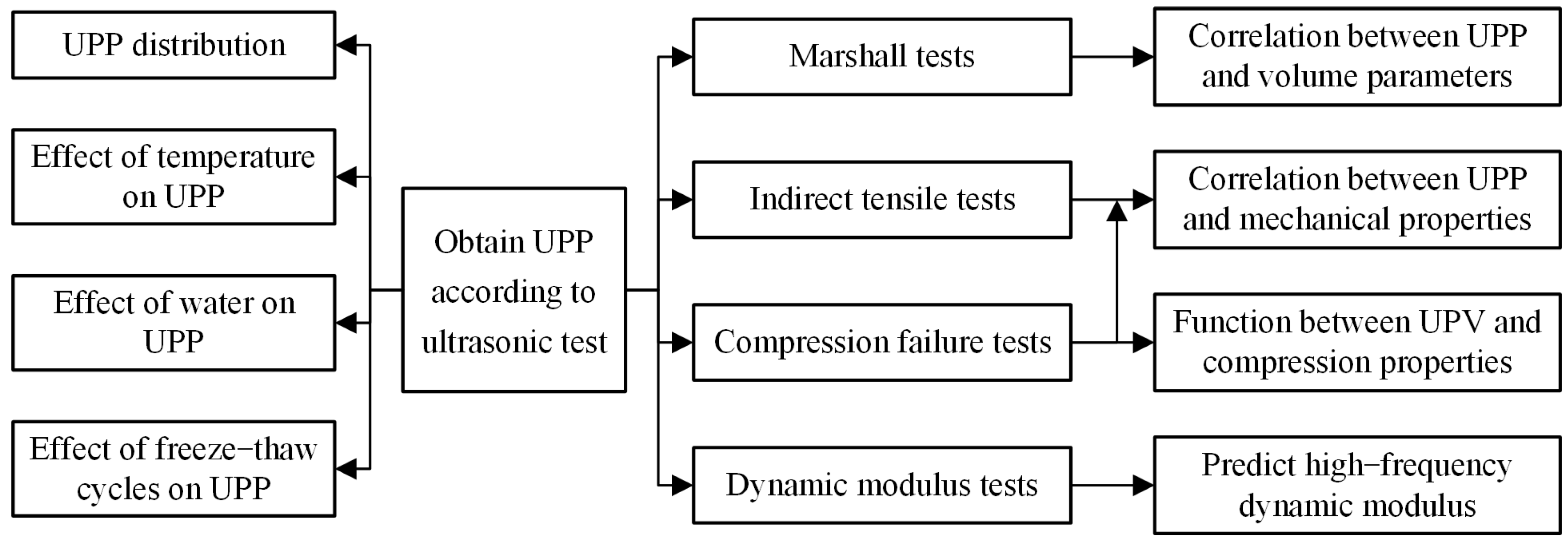
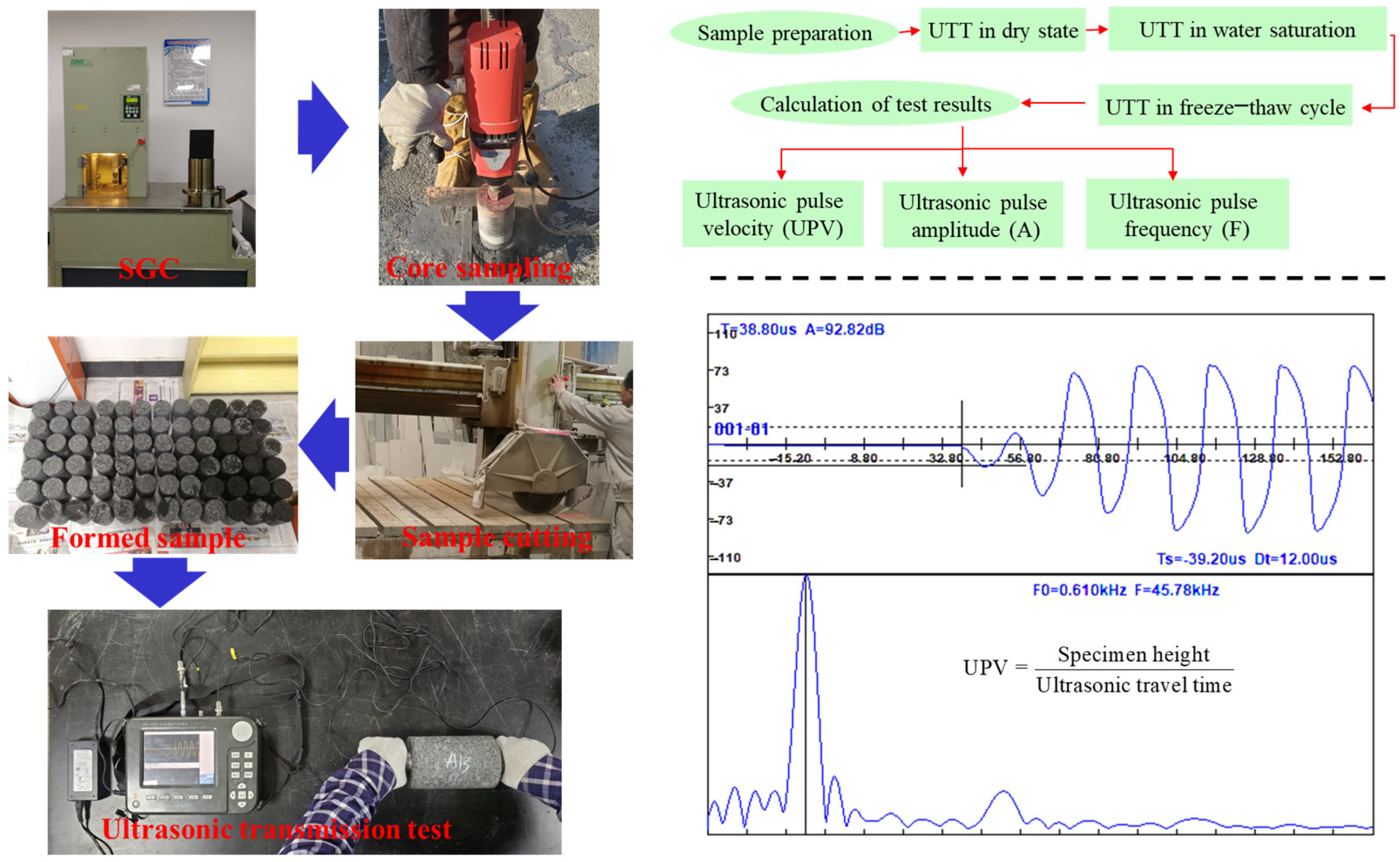
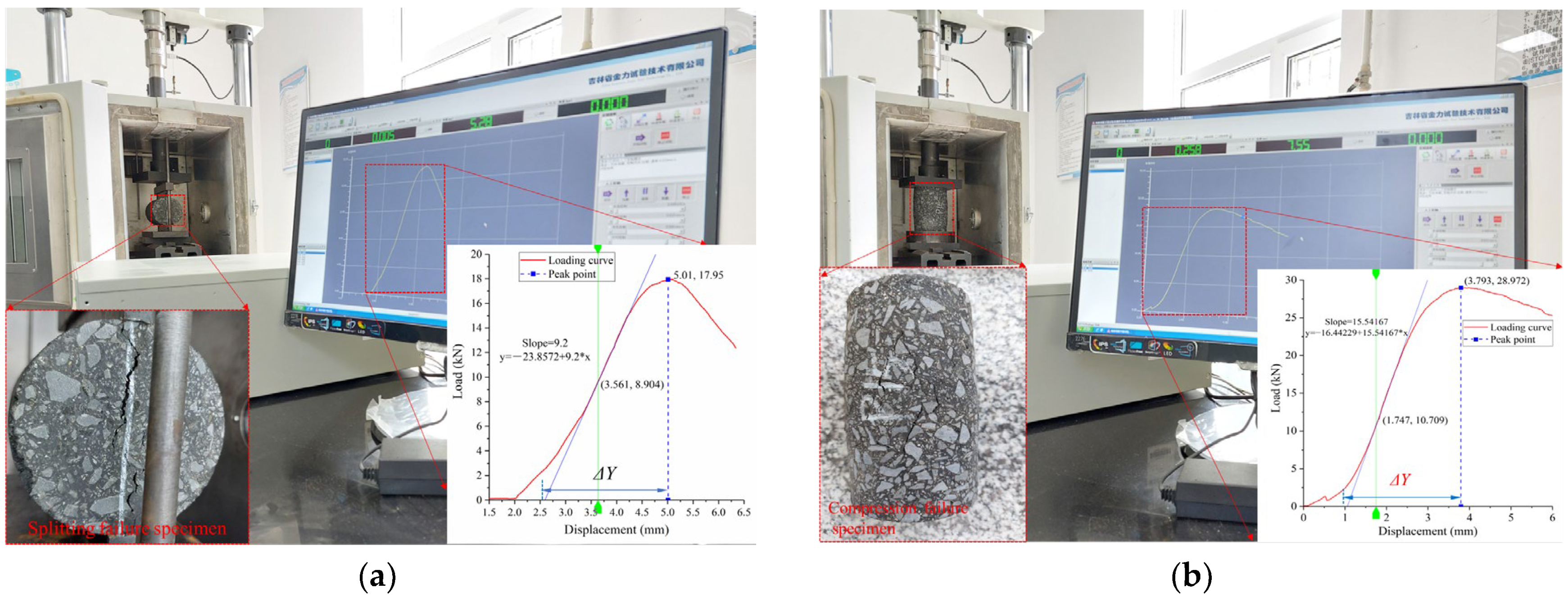
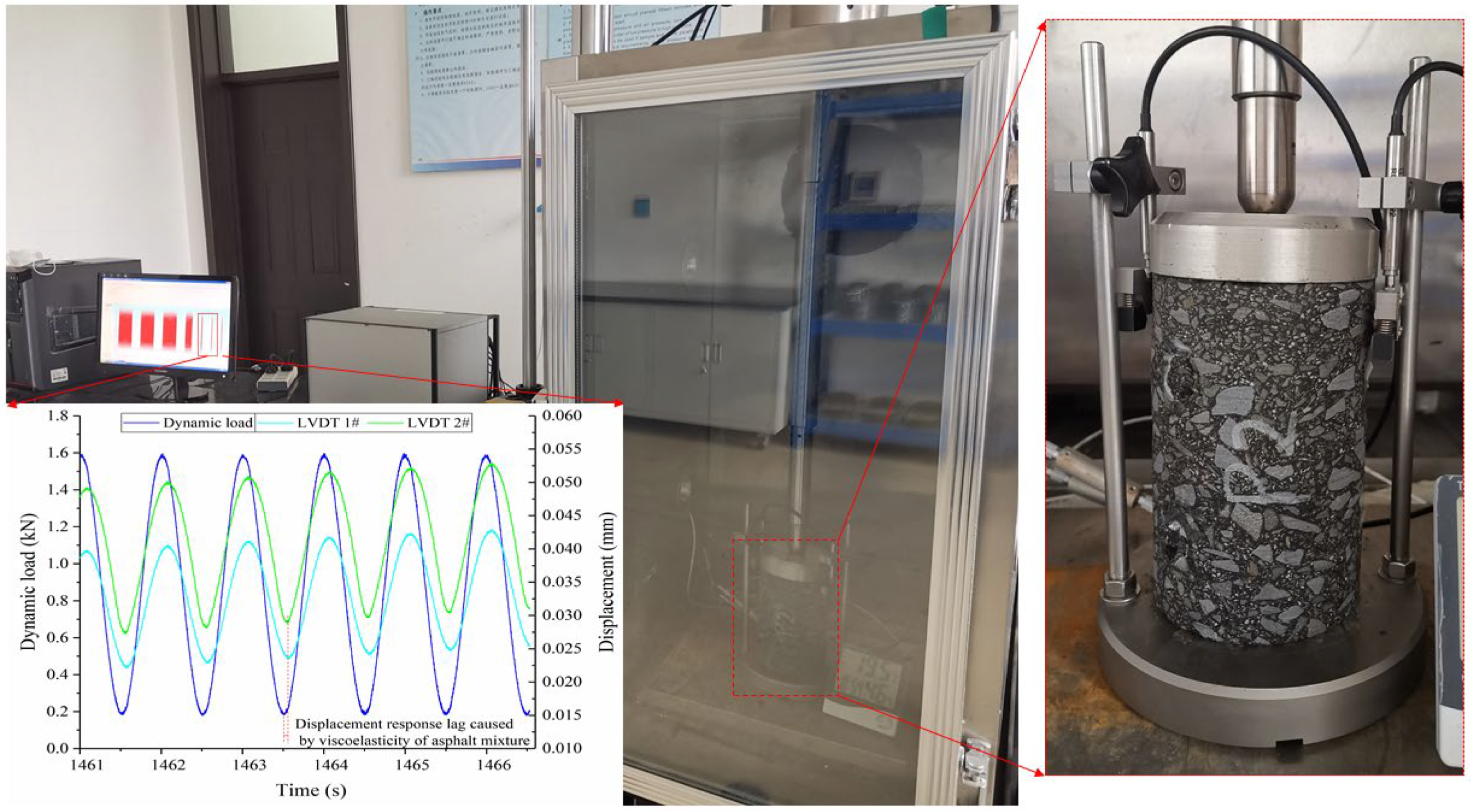
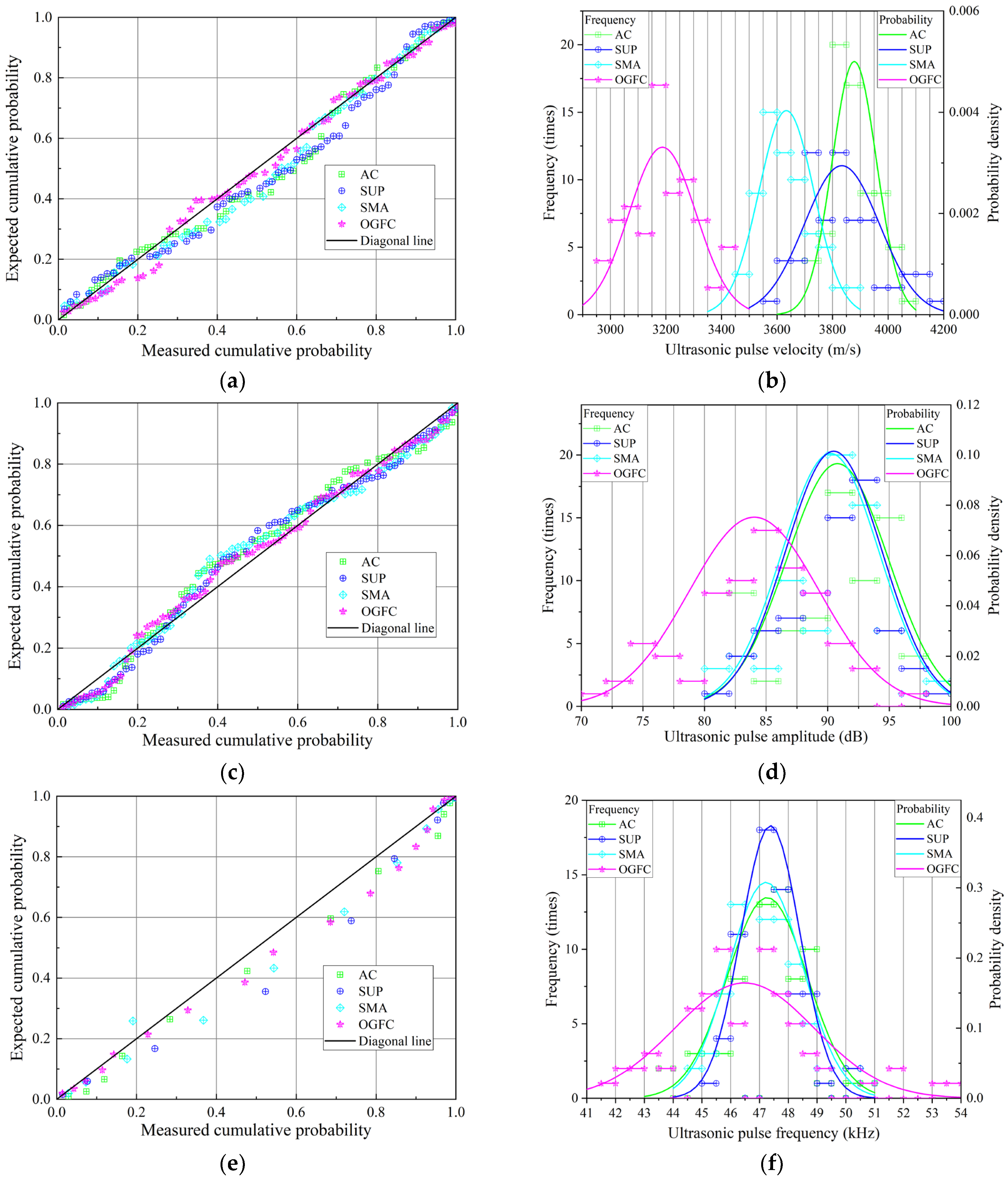
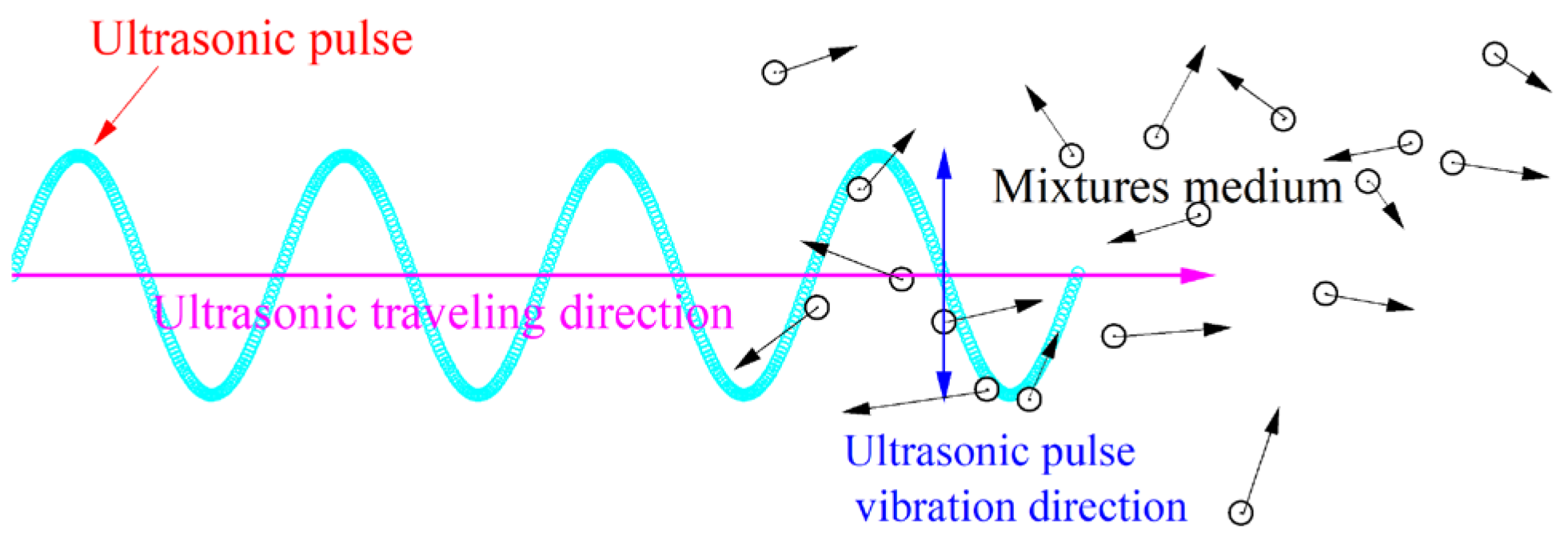

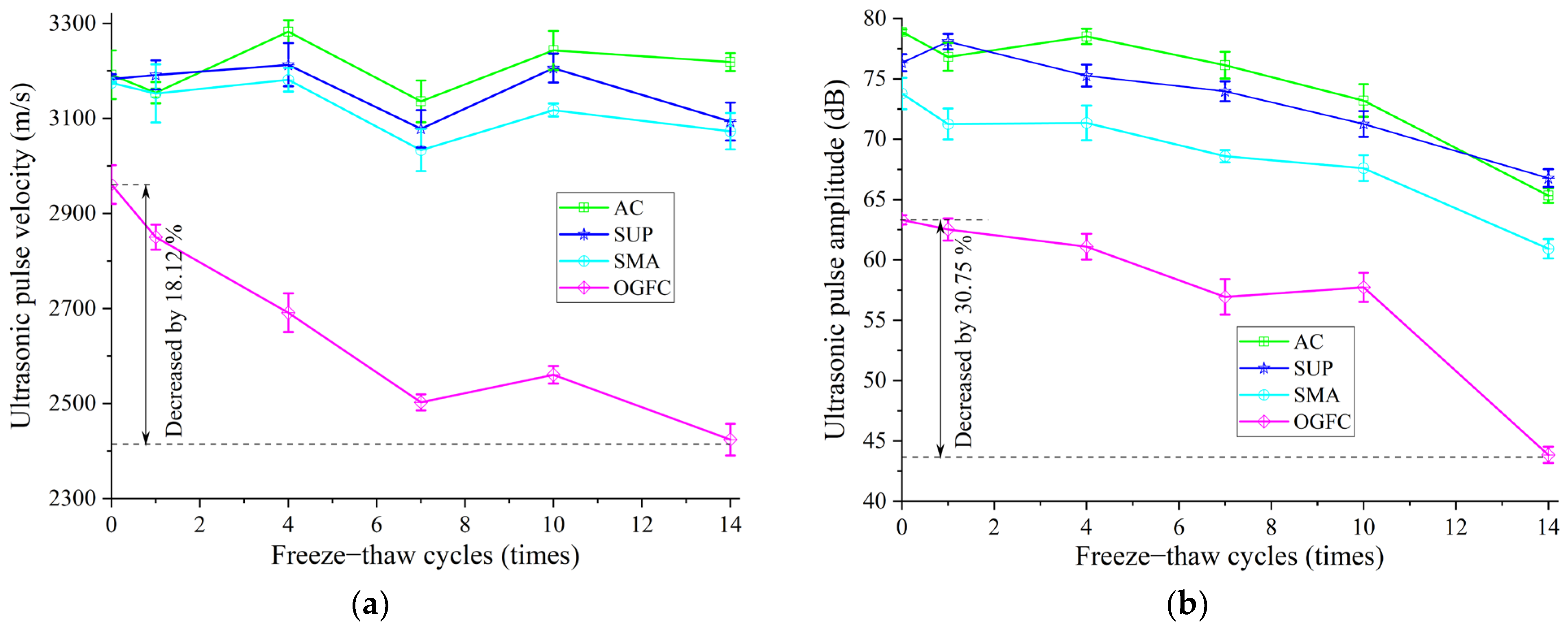
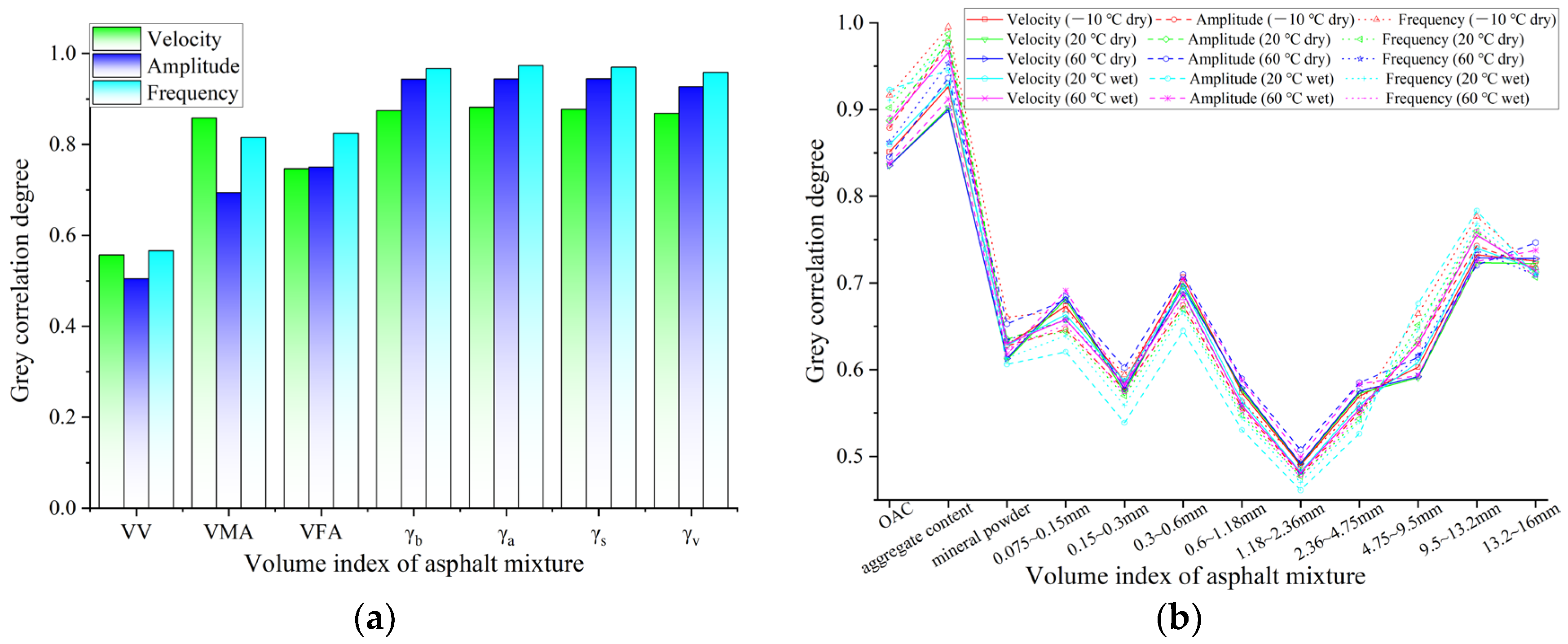
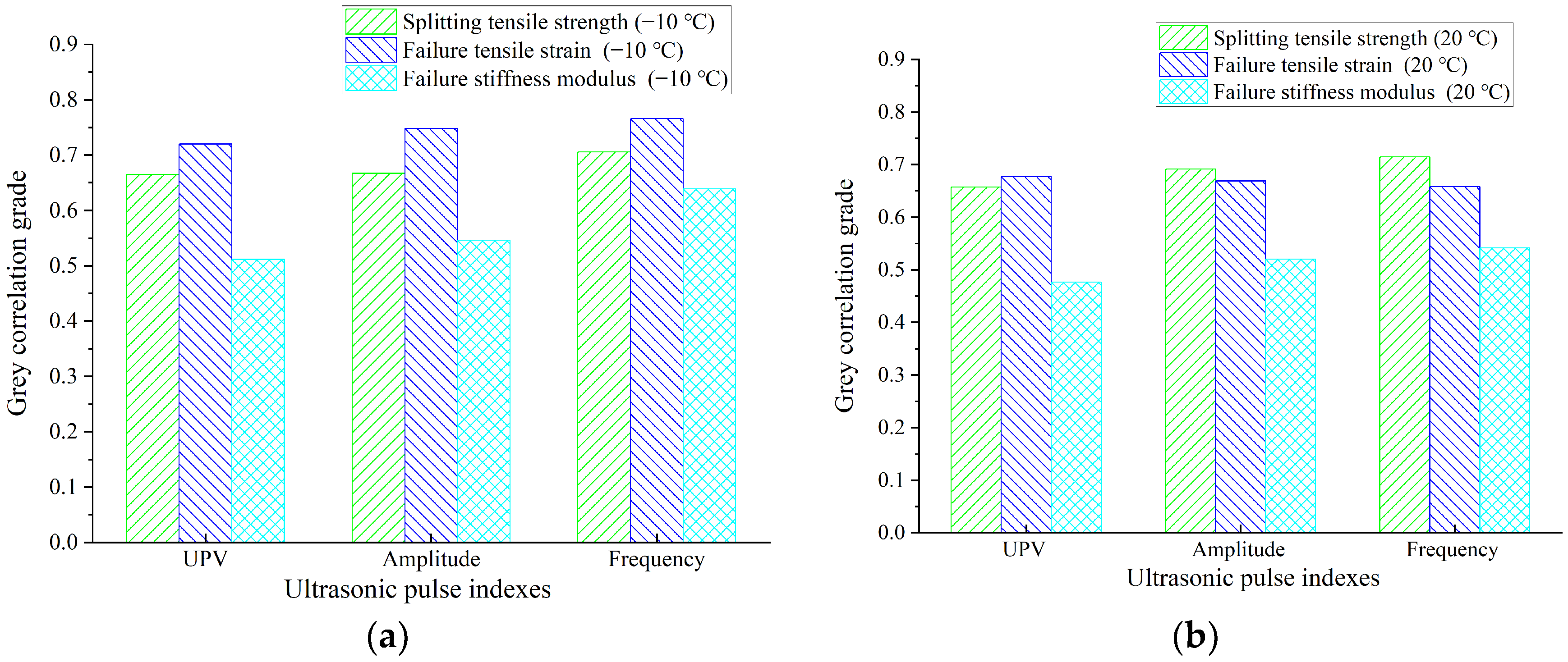
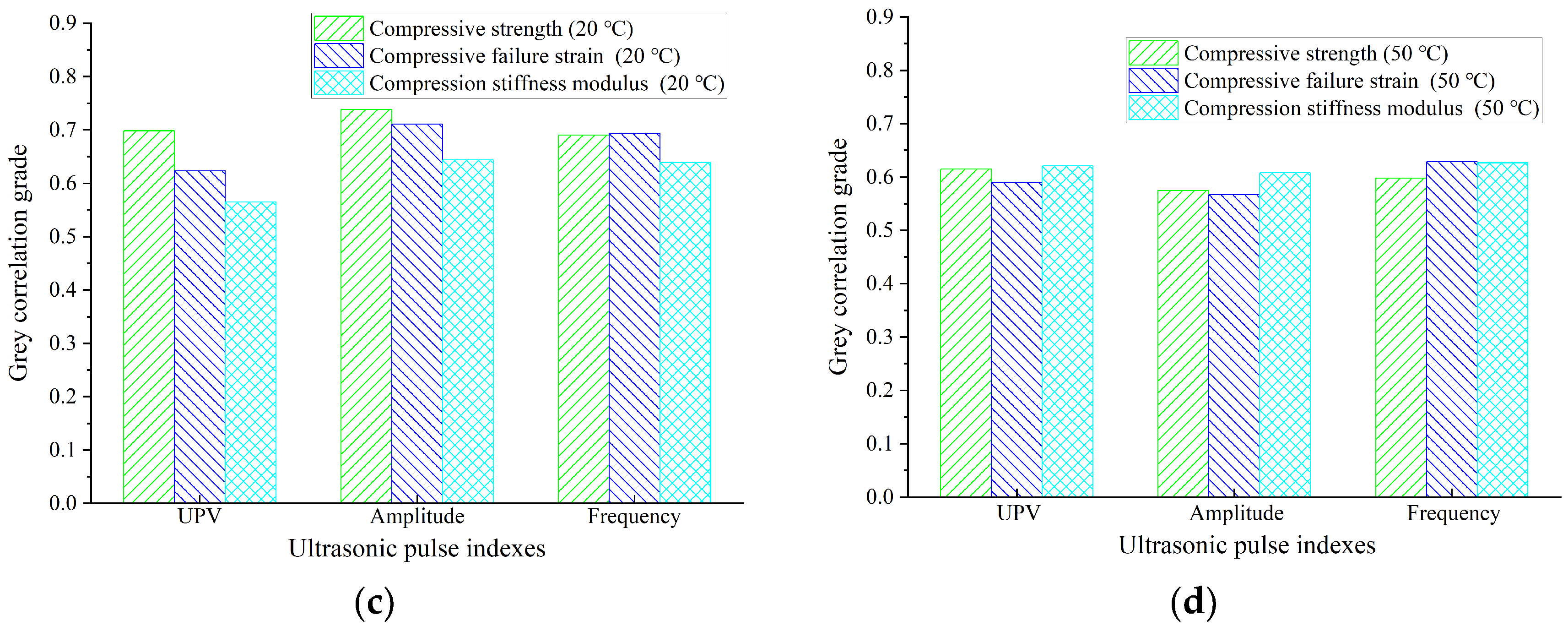

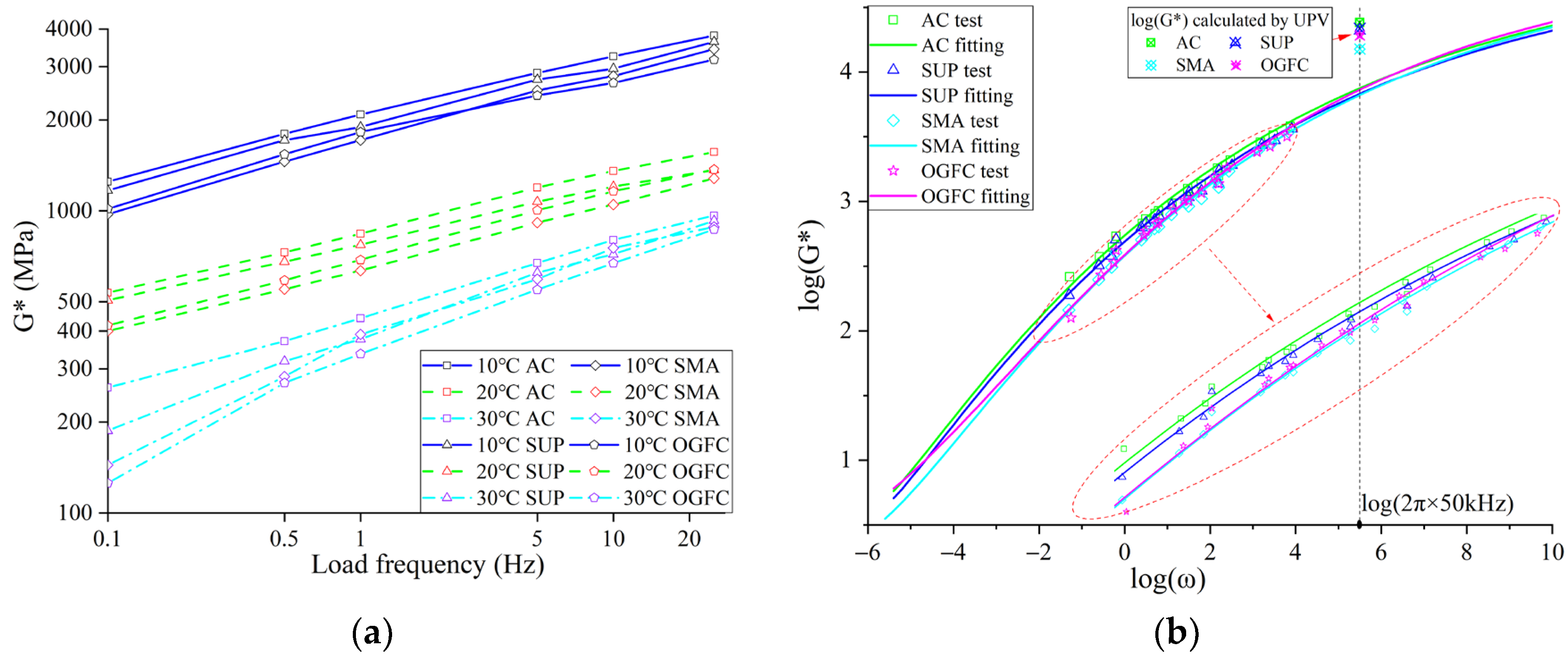
| Gradation Types | Sieve Size | |||||||||
|---|---|---|---|---|---|---|---|---|---|---|
| 0.075 mm | 0.15 mm | 0.3 mm | 0.6 mm | 1.18 mm | 2.36 mm | 4.75 mm | 9.5 mm | 13.2 mm | 16 mm | |
| AC (%) | 6 | 10 | 13.5 | 19 | 26.5 | 37 | 53 | 76.5 | 95 | 100 |
| SUP (%) | 3 | 5 | 12 | 15 | 22 | 35 | 50 | 70 | 91 | 100 |
| SMA (%) | 10 | 12 | 13 | 16 | 19 | 20.5 | 27 | 62.5 | 95 | 100 |
| OGFC (%) | 4 | 5.5 | 7.5 | 9.5 | 12 | 16 | 21 | 70 | 95 | 100 |
| Properties | Standard Range | Test Value |
|---|---|---|
| 25 °C Penetration (0.1 mm) | 60~80 | 67.9 |
| Ductility (cm) at 5 °C | ≥20 | 26.8 |
| Softening point TR and B (°C) | ≥65 | 76.4 |
| Elastic recovery (%) at 25 °C | ≥85 | 90.3 |
| After aging test | ||
| Aging mass loss (%) | ≤±0.8 | 0.26 |
| 25 °C Penetration ratio (%) | ≥60 | 81.5 |
| Residual ductility (cm) at 5 °C | ≥10 | 14.4 |
| Gradation Types | Ultrasonic Pulse Velocity (m/s) | Ultrasonic Pulse Amplitude (dB) | Main Frequency of Ultrasonic Pulse (kHz) | |||
|---|---|---|---|---|---|---|
| μ | σ | μ | σ | μ | σ | |
| AC | 3878.33 | 78.477 | 90.80 | 4.121 | 47.27 | 1.394 |
| SUP | 3833.64 | 134.737 | 90.49 | 3.919 | 47.38 | 1.026 |
| SMA | 3633.69 | 97.921 | 90.23 | 3.954 | 47.22 | 1.295 |
| OGFC | 3187.71 | 119.728 | 84.04 | 5.295 | 46.48 | 2.425 |
| Gradation Types | Variation Rate of UPV (%) | Variation Rate of Amplitude (%) | ||||
|---|---|---|---|---|---|---|
| From −20 °C to 60 °C (Dry) | From 10 °C to 60 °C (Dry) | From 10 °C to 60 °C (Water) | From −20 °C to 60 °C (Dry) | From 10 °C to 60 °C (Dry) | From 10 °C to 60 °C (Water) | |
| AC | 29.69 | 26.16 | 26.14 | 19.42 | 15.89 | 13.73 |
| SUP | 30.47 | 27.02 | 25.47 | 21.19 | 16.83 | 18.60 |
| SMA | 29.89 | 26.59 | 25.15 | 23.12 | 20.27 | 21.60 |
| OGFC | 33.87 | 28.81 | 22.95 | 25.42 | 21.45 | 36.23 |
| Mixs | Fitting Parameters | Dynamic Modulus Comparison | |||||||
|---|---|---|---|---|---|---|---|---|---|
| Log (Gmin) | Log (Gmax) | β | γ | λ | R2 | Log (Calculated Value of Model) | Log (Calculated Value of UPV) | Prediction Error (%) | |
| AC | 0.69 | 4.938 | −0.607 | −0.138 | −0.846 | 0.9966 | 3.877 | 4.384 | 11.58 |
| SUP | 0.675 | 4.912 | −0.599 | −0.136 | −0.861 | 0.9956 | 3.831 | 4.336 | 11.63 |
| SMA | 0.45 | 4.935 | −0.548 | −0.147 | −0.712 | 0.9967 | 3.824 | 4.178 | 8.47 |
| OGFC | 0.433 | 4.884 | −0.471 | −0.169 | −0.428 | 0.9942 | 3.863 | 4.284 | 9.84 |
Disclaimer/Publisher’s Note: The statements, opinions and data contained in all publications are solely those of the individual author(s) and contributor(s) and not of MDPI and/or the editor(s). MDPI and/or the editor(s) disclaim responsibility for any injury to people or property resulting from any ideas, methods, instructions or products referred to in the content. |
© 2023 by the authors. Licensee MDPI, Basel, Switzerland. This article is an open access article distributed under the terms and conditions of the Creative Commons Attribution (CC BY) license (https://creativecommons.org/licenses/by/4.0/).
Share and Cite
Tan, X.; Wu, C.; Li, L.; Li, H.; Liang, C.; Zhao, Y.; Li, H.; Zhao, J.; Wang, F. Sensitivity and Reliability Analysis of Ultrasonic Pulse Parameters in Evaluating the Laboratory Properties of Asphalt Mixtures. Materials 2023, 16, 6852. https://doi.org/10.3390/ma16216852
Tan X, Wu C, Li L, Li H, Liang C, Zhao Y, Li H, Zhao J, Wang F. Sensitivity and Reliability Analysis of Ultrasonic Pulse Parameters in Evaluating the Laboratory Properties of Asphalt Mixtures. Materials. 2023; 16(21):6852. https://doi.org/10.3390/ma16216852
Chicago/Turabian StyleTan, Xiaoshu, Chunli Wu, Liding Li, He Li, Chunyu Liang, Yongchao Zhao, Hanjun Li, Jing Zhao, and Fuen Wang. 2023. "Sensitivity and Reliability Analysis of Ultrasonic Pulse Parameters in Evaluating the Laboratory Properties of Asphalt Mixtures" Materials 16, no. 21: 6852. https://doi.org/10.3390/ma16216852
APA StyleTan, X., Wu, C., Li, L., Li, H., Liang, C., Zhao, Y., Li, H., Zhao, J., & Wang, F. (2023). Sensitivity and Reliability Analysis of Ultrasonic Pulse Parameters in Evaluating the Laboratory Properties of Asphalt Mixtures. Materials, 16(21), 6852. https://doi.org/10.3390/ma16216852






